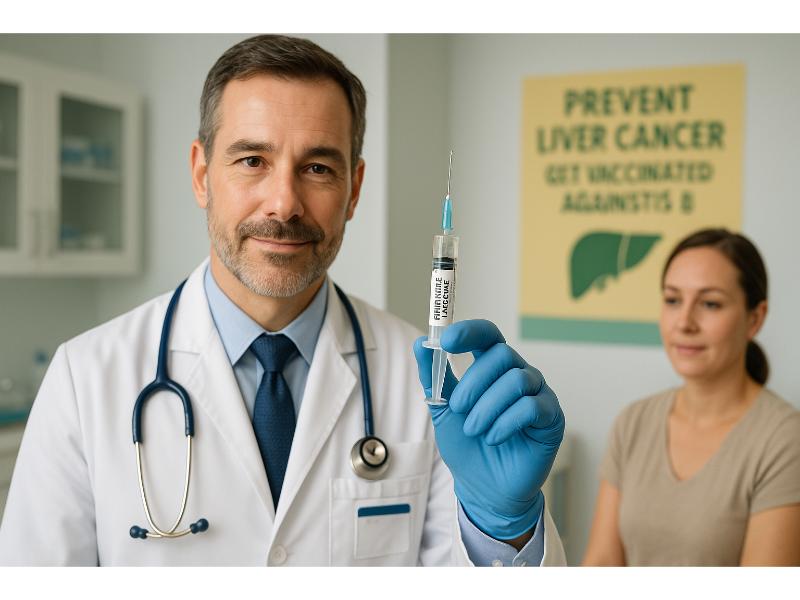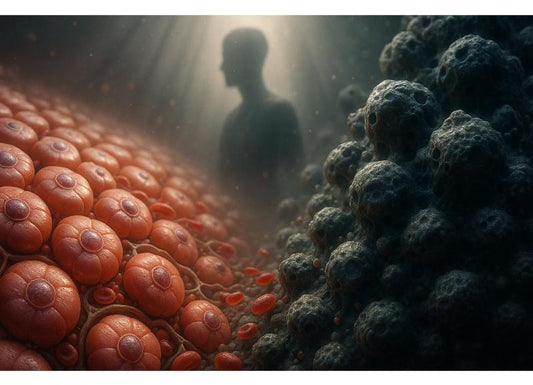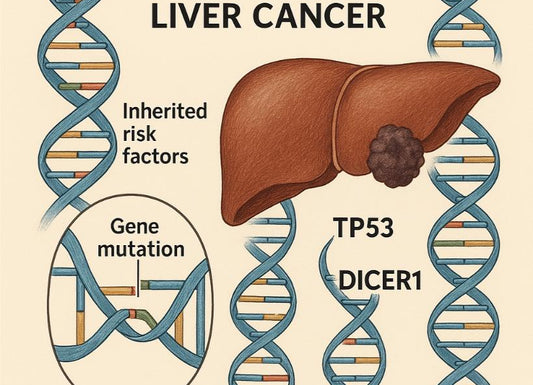How to Prevent Liver Cancer? Understanding Symptoms and Prevention
 Written By
Jaclyn P. Leyson-Azuela, RMT, MD, MPH
Written By
Jaclyn P. Leyson-Azuela, RMT, MD, MPH

Liver cancer is one of the most serious health challenges worldwide. Understanding your risk factors and taking proactive steps can significantly reduce your chances of developing this disease. Whether you’re concerned about family history, existing liver conditions, or simply want to protect your long-term health, knowing how to safeguard your liver matters.
This article walks you through the causes, prevention strategies, and warning signs of liver cancer so you can make informed decisions about your health.
Key Insights
-
Hepatitis B and C infections account for nearly 80% of liver cancer cases globally. Vaccination and antiviral treatment are critical prevention tools.
-
Nonalcoholic fatty liver disease (NAFLD) affects approximately 25% of the global population and significantly increases liver cancer risk.
-
Maintaining a healthy weight, avoiding excessive alcohol, and getting vaccinated against hepatitis B can reduce your liver cancer risk by up to 70%.
-
Early-stage liver cancer often shows no symptoms, making routine screening essential for high-risk individuals.
-
Blood transfusions in developed countries carry an extremely low risk of transmitting infections due to rigorous screening protocols.
-
Simple lifestyle changes like eating whole foods, exercising regularly, and avoiding toxins can reverse early-stage fatty liver disease.
What Is Hepatocellular Carcinoma? How Is It Dangerous?
Hepatocellular carcinoma (HCC) is the most common type of primary liver cancer, starting in the main liver cells called hepatocytes. This form accounts for about 75-85% of all primary liver cancers diagnosed worldwide.
The danger of HCC lies in how it develops and spreads:
-
Silent progression
The liver can function normally even when partially damaged, so HCC often grows without obvious symptoms until reaching advanced stages.
-
Rapid growth potential
Once established, HCC can grow quickly and spread to other parts of the liver or beyond.
-
Limited treatment options
Advanced HCC is difficult to treat because the liver is already compromised, limiting surgical options, and reduces the body’s tolerance to chemotherapy.
-
High recurrence rates
Even after successful treatment, HCC tends to return, requiring ongoing monitoring.
The five-year survival rate for liver cancer varies dramatically based on when it’s detected. Localized liver cancer caught early has a 70% five-year survival rate. But this drops to less than 12.5% when the cancer has advanced.
HCC typically develops in livers already damaged by chronic conditions like cirrhosis, hepatitis, or fatty liver disease. The damaged liver tissue creates an environment where abnormal cells can multiply unchecked.
Can Liver Cancer Be Prevented?
Yes, liver cancer can often be prevented, and you have more control over your risk than you might think. It is shown that liver cancer cases could be avoided through specific actions and lifestyle choices.
The key is addressing the root causes before they damage your liver. Since most liver cancers develop in livers already affected by chronic disease, preventing that underlying damage is your best defense.
How to Prevent Liver Cancer?
Here's what works to lower your risk:
Get vaccinated against hepatitis B
This vaccine is one of the first cancer-prevention vaccines ever developed. If you weren’t vaccinated as a child, talk to your doctor about getting it now. It’s safe and effective at any age.
Get tested for hepatitis C
Unlike hepatitis B, there is no vaccine for hepatitis C. But it can be cured with antiviral medications. Many people have hepatitis C without knowing it. So, testing is critical if you were born between 1945 and 1965, received blood transfusions before 1992, or ever used injection drugs.
Limit alcohol consumption
Excessive drinking is a leading cause of cirrhosis. For most adults, moderate drinking means up to one drink per day for women and up to two for men. But if you already have liver disease, avoid alcohol completely.
Maintain a healthy weight
Obesity contributes to fatty liver disease, which can progress to cirrhosis and cancer. Even losing 7-10% of your body weight can significantly improve liver health.
Avoid tobacco products
Smoking doesn't just harm your lungs. It increases liver cancer risk and worsens existing liver disease.
Be cautious with medications and supplements
Your liver processes everything you swallow. Taking too much acetaminophen (Tylenol) or mixing it with alcohol can cause serious liver damage. Some herbal supplements can also harm your liver.
Protect yourself from aflatoxins
These cancer-causing substances are produced by mold that grows on improperly stored grains, nuts, and seeds. Store these foods in cool, dry places and discard anything that looks or smells moldy.
Practice safe behaviors
Use condoms to reduce the risk of hepatitis B and C transmission, and never share needles, razors, or toothbrushes.
Does a Strong Immune System Lower One's Risk of Liver Cancer?
A healthy immune system plays a supporting role in reducing liver cancer risk. But it's not the complete solution. Your immune system helps fight off viral infections like hepatitis B and C and can identify and destroy some abnormal cells before they become cancerous.
However, the relationship between immunity and liver cancer is complex:
-
A strong immune system can help control chronic hepatitis infections, reducing the viral load and subsequent liver damage.
-
People with weakened immune systems (from HIV, organ transplants, or immunosuppressive medications) face higher liver cancer risks.
-
Once chronic liver damage and cirrhosis develop, even a robust immune system struggles to prevent cancer from forming in that damaged tissue.
The bottom line: While supporting your immune health through adequate sleep, stress management, nutritious eating, and regular exercise is beneficial, it cannot replace targeted prevention strategies like vaccination, antiviral treatment, and avoiding liver toxins.

What Causes Primary Liver Cancer?
Primary liver cancer develops when cells in the liver begin to grow abnormally and uncontrollably. Several factors can trigger this transformation:
-
Chronic hepatitis B and C infections
These viral infections cause ongoing inflammation and damage to liver cells over many years. The constant cycle of cell death and regeneration increases the chances of genetic mutations that lead to cancer.
-
Cirrhosis
This severe scarring of the liver can result from alcohol abuse, viral hepatitis, fatty liver disease, or autoimmune conditions. Cirrhotic livers have a significantly elevated cancer risk regardless of what caused the scarring.
-
Excessive alcohol consumption
Long-term heavy drinking damages liver cells and causes inflammation, eventually leading to cirrhosis in many cases.
-
Non-alcoholic fatty liver disease (NAFLD)
Fat buildup in the liver can progress from simple fatty liver to inflammation (NASH), then to scarring (fibrosis), cirrhosis, and finally to cancer.
-
Diabetes and metabolic syndrome
These conditions are closely linked to fatty liver disease and increase cancer risk through multiple pathways involving insulin resistance and chronic inflammation.
These toxins, produced by certain molds, can directly damage liver cell DNA.
-
Inherited liver diseases
Conditions like hemochromatosis (iron overload) and Wilson's disease (copper accumulation) can increase cancer risk.
-
Smoking
Tobacco use roughly doubles your risk of liver cancer.
Many of these factors are modifiable. You can get vaccinated, treat infections, change drinking habits, lose weight, and control diabetes, all actions that directly address the root causes.
Is Fatty Liver Disease Increasing Your Cancer Risk?
Yes, fatty liver disease does increase your cancer risk. It's becoming a growing concern as rates of obesity and diabetes climb worldwide. Nonalcoholic fatty liver disease (NAFLD) now affects roughly one in four adults globally, making it the most common liver condition.
Here's how fatty liver disease raises your cancer risk:
-
Progression pathway: NAFLD can advance through stages—simple fatty liver (steatosis) → liver inflammation (NASH) → scarring (fibrosis) → cirrhosis → cancer.
-
Inflammation factor: Fat accumulation triggers chronic inflammation, which damages liver cells and can lead to DNA changes that promote cancer.
-
Metabolic dysfunction: NAFLD is often accompanied by insulin resistance, which creates an environment that supports cancer cell growth.
-
Direct cancer risk: Some people with NAFLD develop liver cancer even without progressing to cirrhosis first, though this is less common.
The good news is that fatty liver disease, especially in its early stages, is reversible. Your liver has remarkable regenerative abilities when given the right support.
Risk is particularly elevated when NAFLD progresses to NASH (nonalcoholic steatohepatitis), the inflammatory form of the disease. Studies suggest that people with NASH have a liver cancer risk similar to those with hepatitis C, emphasizing why early intervention matters.
What Lifestyle Changes Can Reverse or Manage Fatty Liver?
Reversing fatty liver disease doesn't require extreme measures, consistent, moderate changes make the biggest difference.
|
Dietary Changes |
Physical Activity |
Other Important Changes |
|
|
|
Most people see improvements in liver function tests within 3-6 months of making these changes. Some studies show that liver fat can decrease by up to 40-50% with sustained lifestyle modifications.

How Do We Reduce Nonalcoholic Fatty Liver?
Reducing nonalcoholic fatty liver requires a comprehensive approach targeting the underlying metabolic issues that caused fat accumulation in the first place.
Medical management strategies:
-
Blood sugar control
If you have diabetes or prediabetes, work with your doctor to manage it through medication and lifestyle changes. Some diabetes medications like pioglitazone and GLP-1 agonists have shown benefits for fatty liver.
-
Manage cholesterol and triglycerides
High blood fats contribute to liver fat accumulation. Medications called statins are generally safe for people with fatty liver and can help.
-
Address insulin resistance
This is often the root problem. Metformin, a diabetes medication, may help some people with fatty liver, though it's not specifically approved for this use.
-
Consider vitamin E supplementation
For people with NASH (the inflammatory form), high-dose vitamin E (800 IU daily) has shown benefits in some studies. But only take this under medical supervision.
Monitoring and follow-up:
-
Get regular blood tests to track liver enzymes and function.
-
You may also take advantage of at-home liver testing between medical appointments
-
Your doctor may recommend periodic imaging (ultrasound, FibroScan, or MRI) to assess liver fat and scarring.
-
Watch for signs of progression like unexplained fatigue, abdominal swelling, or easy bruising.
What doesn't work:
-
"Liver cleanses" and detox products. Your liver detoxifies itself when healthy.
-
Rapid weight loss through crash diets. This can worsen liver inflammation.
-
Supplements claiming to "flush" liver fat. There's no quick fix.
The most effective approach combines gradual weight loss, improved nutrition, regular physical activity, and management of related metabolic conditions. Consistency matters more than perfection, small, sustainable changes add up to significant liver health improvements over time.
What Are Liver Cancer Causes and Treatment?
Treatment depends heavily on the cancer stage, liver function, and your overall health:
|
Early, Localized Tumors |
Intermediate-Stage Tumors |
Advanced Stage |
Supportive Care |
|
|
|
|
Prevention and early detection are so critical, treatment is far more effective when the cancer is caught early.
What Is Liver Cancer and Its Warning Signs?

Liver cancer is a malignancy that starts in the liver cells, most commonly as hepatocellular carcinoma. Understanding its warning signs can help you catch it earlier, when treatment is most effective.
The challenge with liver cancer is that early stages often produce no symptoms at all. The liver can continue functioning fairly well even with significant damage, so by the time symptoms appear, the cancer may be advanced.
Common warning signs include:
-
Unexplained weight loss
-
Upper abdominal pain
-
Abdominal swelling
-
Yellowing of skin and eyes
-
Unusual fatigue
-
Nausea and vomiting
-
Enlarged liver
-
Fever
-
Changes in stool or urine
-
Easy bruising or bleeding
Important to know:
Many of these symptoms can be caused by conditions far less serious than cancer, hepatitis, gallstones, or other digestive issues. However, if you have risk factors for liver cancer (chronic hepatitis, cirrhosis, fatty liver disease, or heavy alcohol use) and develop these symptoms, see your doctor promptly.
For people at high risk, regular screening with blood tests (alpha-fetoprotein) and imaging (ultrasound or CT scans) every six months can detect liver cancer before symptoms appear. Early detection dramatically improves treatment success.

Can You Get Cancer From a Blood Transfusion?
The short answer is that blood transfusions in developed countries carry an extremely low risk of transmitting infections that could eventually lead to liver cancer. Modern blood screening has made transfusions remarkably safe.
Here's the background: In the past, before comprehensive blood screening began in the early 1990s, blood transfusions could transmit hepatitis B and C viruses. Since chronic hepatitis infections significantly increase liver cancer risk, some people who received contaminated blood decades ago did develop liver cancer years later.
Related Resources:
Is Liver Cancer Hereditary? Genetic Risks and Family History
Is Liver Cancer Curable? Things to Know
Quick Summary Box
-
Liver cancer prevention focuses on vaccination against hepatitis B, treating hepatitis C, maintaining healthy weight, limiting alcohol, and avoiding liver toxins.
-
Hepatocellular carcinoma accounts for 75-85% of primary liver cancers and develops most often in already-damaged livers affected by cirrhosis, hepatitis, or fatty liver disease.
-
Nonalcoholic fatty liver disease affects approximately 25% of adults worldwide and significantly increases cancer risk as it progresses through inflammation and scarring stages.
-
Reversing fatty liver requires gradual weight loss, dietary changes focusing on whole foods while reducing sugars and refined carbs, and at least 150 minutes of weekly physical activity.
-
Early-stage liver cancer rarely causes symptoms, making regular screening essential for high-risk individuals to catch cancer when treatment is most effective.
-
Warning signs of advanced liver cancer include unexplained weight loss, upper abdominal pain, jaundice, persistent fatigue, and abdominal swelling.
References
Asafo-Agyei, K. O., & Samant, H. (2023). Hepatocellular carcinoma. PubMed; StatPearls Publishing. https://www.ncbi.nlm.nih.gov/books/NBK559177/
Batheja, S., Sahoo, R. K., Tarannum, S., Vaiphei, K. K., Jha, S., Alexander, A., Goyal, A. K., & Gupta, U. (2023). Hepatocellular carcinoma: Preclinical and clinical applications of nanotechnology with the potential role of carbohydrate receptors. Biochimica et Biophysica Acta (BBA) - General Subjects, 1867(10), 130443. https://doi.org/10.1016/j.bbagen.2023.130443
CDC. (2024, April 12). Treatment of Hepatitis C. Hepatitis C. https://www.cdc.gov/hepatitis-c/treatment/index.html
How Fatty Liver Disease Helps Cancer Thrive in the Liver - NCI. (2023, July 6). Www.cancer.gov. https://www.cancer.gov/news-events/cancer-currents-blog/2023/fatty-liver-disease-cancer-metastasis
Kim, K.-S., & Lee, B.-W. (2020). Beneficial effect of anti-diabetic drugs for nonalcoholic fatty liver disease. Clinical and Molecular Hepatology, 26(4), 430–443. https://doi.org/10.3350/cmh.2020.0137
Litten, R., Kwako, L., & Gardner, M. (2024, February 27). The basics: Defining how much alcohol is too much | National Institute on Alcohol Abuse and Alcoholism (NIAAA). Www.niaaa.nih.gov. https://www.niaaa.nih.gov/health-professionals-communities/core-resource-on-alcohol/basics-defining-how-much-alcohol-too-much
Liver Cancer Screening - NCI. (2022, May 19). Www.cancer.gov. https://www.cancer.gov/types/liver/what-is-liver-cancer/screening
National Cancer Institute. (2015). Aflatoxins. National Cancer Institute; Cancer.gov. https://www.cancer.gov/about-cancer/causes-prevention/risk/substances/aflatoxins
National Cancer Institute. (2022, May 19). Liver Cancer Causes, Risk Factors, and Prevention - NCI. Www.cancer.gov. https://www.cancer.gov/types/liver/what-is-liver-cancer/causes-risk-factors
Oladipupo, S. O., Ezenabor, E. H., Ojo, A. B., Ogunlakin, A. D., & Ojo, O. A. (2025). Interplay of the pathophysiological mechanisms of non-alcoholic fatty liver disease, diabetes mellitus, and inflammation: A growing threat to public health. Obesity Medicine, 55, 100613. https://doi.org/10.1016/j.obmed.2025.100613
Prabhakar, O., & Bhuvaneswari, M. (2020). Role of diet and lifestyle modification in the management of nonalcoholic fatty liver disease and type 2 diabetes. Tzu Chi Medical Journal, 0(0), 0. https://doi.org/10.4103/tcmj.tcmj_86_20
Romero-Gómez, M., Zelber-Sagi, S., & Trenell, M. (2017). Treatment of NAFLD with diet, physical activity and exercise. Journal of Hepatology, 67(4), 829–846. https://doi.org/10.1016/j.jhep.2017.05.016
Wang, W., & Wei, C. (2020). Advances in the early diagnosis of hepatocellular carcinoma. Genes & Diseases, 7(3). https://doi.org/10.1016/j.gendis.2020.01.014
Young, M., & John, S. (2020). Hepatic Chemoembolization. PubMed; StatPearls Publishing. https://www.ncbi.nlm.nih.gov/books/NBK507822/
Zelber-Sagi, S., Noureddin, M., & Shibolet, O. (2021). Lifestyle and Hepatocellular Carcinoma What Is the Evidence and Prevention Recommendations. Cancers, 14(1), 103. https://doi.org/10.3390/cancers14010103

Jaclyn P. Leyson-Azuela, RMT, MD, MPH, is a licensed General Practitioner and Public Health Expert. She currently serves as a physician in private practice, combining clinical care with her passion for preventive health and community wellness.



